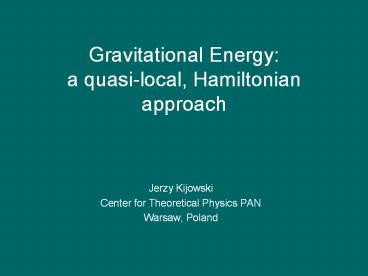Gravitational Energy: a quasi-local, Hamiltonian approach - PowerPoint PPT Presentation
Title:
Gravitational Energy: a quasi-local, Hamiltonian approach
Description:
Gravitational Energy: a quasi-local, Hamiltonian approach Jerzy Kijowski Center for Theoretical Physics PAN Warsaw, Poland – PowerPoint PPT presentation
Number of Views:123
Avg rating:3.0/5.0
Title: Gravitational Energy: a quasi-local, Hamiltonian approach
1
Gravitational Energya quasi-local, Hamiltonian
approach
- Jerzy Kijowski
- Center for Theoretical Physics PAN
- Warsaw, Poland
2
Energy estimates in field theory
Field energy, if positive, enables a priori
estimations.
3
Gravitational energy
In special relativity field energy obtained via
Noether theorem
But no energy-momentum tensor of gravitational
field!
No space-time symmetry
or too many symmetries!
Various pseudotensors have been proposed. They
do not describe correctly gravitational energy!
4
Bulk versus boundary
Standard Hamiltonian approaches to
special-relativistic field theory is based on
integration by parts and neglecting
surface integrals at infinity (fall of
conditions).
Paradigm functional-analytic framework for
description of Cauchy data must be chosen in such
a way that the boundary integrals vanish
automatically!
Trying to mimick these methods in General
Relativity Theory we painfully discover the
opposite rule
General relativity strong fall off conditions
trivialize the theory.
5
Quasi-local approach
Meanwhile, many (more than 20) different
definitions of a quasi-local mass (energy) have
been formulated.
In this talk I want to discuss a general
Hamiltonian framework, where boundary integrals
are not neglected!
This approach covers most of the above 20
different definitions each related to a specific
control mode.
6
Symplectic relations
We begin with a mathematical analysis of energy
as a generator of dynamics in the sense of
symplectic relations.
7
Generating function
8
Energy as a generating function
9
Energy as a generating function
10
Energy as a generating function
Legendre transformation transition from one
control mode to another
11
Mechanics variational formulation
Euler-Lagrange equation in classical mechanics,
together with the definition of canonical momenta
may be written as
12
Mechanics Hamiltonian formulation
13
Scalar field theory
14
Scalar field theory
15
Scalar field theory
The formalism is coordinate-invariant.
Partial derivatives can be organized into
invariant geometric objects jets of sections of
natural bundles over spacetime.
16
Scalar field theory
Field equations can be written in the following
way
index k1,2,3 denotes three space-like
coordinates, index 0 denotes time coordinate.
We denote .
Hamiltonian formulation based on a (31)
decomposition.
17
Scalar field theory
Field equations can be written in the following
way
index k1,2,3 denotes three space-like
coordinates, index 0 denotes time coordinate.
We denote .
18
Scalar field theory
Energy generates dynamics as a relation between
three objects initial data, their time
derivatives and the boundary data.
Field dynamics within V can be made unique (i.e
Cauchy problem well posed) if we impose
boundary conditions annihilating the boundary
term.
19
Scalar field theory
Both evolutions are equally legal.
Which one is the fields true energy?
20
Dirichlet vs. Neuman evolution
21
Electrodynamics
22
Electrodynamics
23
Energy vs. free energy
Different control modes at the boundary
24
Dirichlet vs. Neuman in Electrodynamics
A flavour of the proof for linear Maxwell
theory.
25
Dirichlet vs. Neuman in Electrodynamics
26
Dirichlet vs. Neuman in Electrodynamics
27
General relativity theory
Gravitational field equations Einstein
equations.
Can be derived from various variational
formulations
Examples
Hamiltonian theory based on (31) decomposition
is universal and does not depend upon a
particular variational formula.
Cauchy data on a hypersurface 3-metric and
exterior curvature.
28
General relativity theory
29
General relativity theory
No variational formulation necessary!
30
General relativity theory
31
Fundamental identity
32
Fundamental identity
Now invariant!
33
Fundamental identity
34
Fundamental identity
35
Fundamental identity
36
Fundamental identity
Examples
1) Metric control mode complete metric of T
is controlled.
37
Fundamental identity
Examples
2) Mixed control mode only 2D metric of S
and time-like components of Q controlled.
38
Fundamental identity
39
Conclusions
Fundamental formula natural framework for
quasi-local analysis of gravitational energy.
Valid also for interacting system matter fields
gravity
(if supplemented by appropriate matter terms in
both the Hamiltonian and the control parts).
40
Conclusions
Any choice of the remaining control leads to a
quasi-local energy.
Which one is the true energy and not a free
energy?
Criteria positivity, well posedness,
linearization ...































